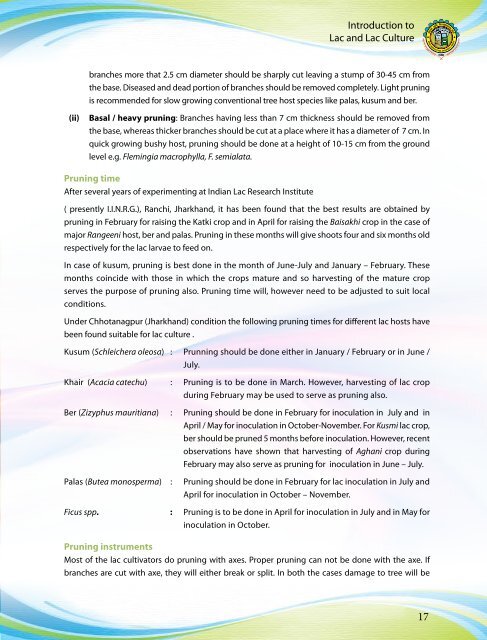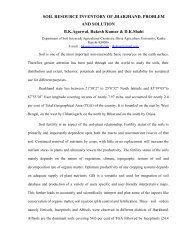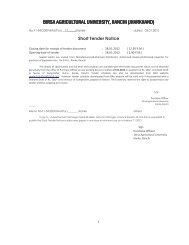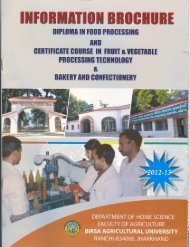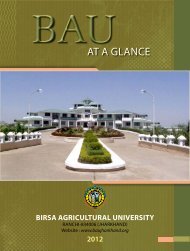Introduction to Lac and Lac Culture - Birsa Agricultural University
Introduction to Lac and Lac Culture - Birsa Agricultural University
Introduction to Lac and Lac Culture - Birsa Agricultural University
Create successful ePaper yourself
Turn your PDF publications into a flip-book with our unique Google optimized e-Paper software.
<strong>Introduction</strong> <strong>to</strong><br />
<strong>Lac</strong> <strong>and</strong> <strong>Lac</strong> <strong>Culture</strong><br />
branches more that 2.5 cm diameter should be sharply cut leaving a stump of 30-45 cm from<br />
the base. Diseased <strong>and</strong> dead portion of branches should be removed completely. Light pruning<br />
is recommended for slow growing conventional tree host species like palas, kusum <strong>and</strong> ber.<br />
(ii) Basal / heavy pruning: Branches having less than 7 cm thickness should be removed from<br />
the base, whereas thicker branches should be cut at a place where it has a diameter of 7 cm. In<br />
quick growing bushy host, pruning should be done at a height of 10-15 cm from the ground<br />
level e.g. Flemingia macrophylla, F. semialata.<br />
Pruning time<br />
After several years of experimenting at Indian <strong>Lac</strong> Research Institute<br />
( presently I.I.N.R.G.), Ranchi, Jharkh<strong>and</strong>, it has been found that the best results are obtained by<br />
pruning in February for raising the Katki crop <strong>and</strong> in April for raising the Baisakhi crop in the case of<br />
major Rangeeni host, ber <strong>and</strong> palas. Pruning in these months will give shoots four <strong>and</strong> six months old<br />
respectively for the lac larvae <strong>to</strong> feed on.<br />
In case of kusum, pruning is best done in the month of June-July <strong>and</strong> January – February. These<br />
months coincide with those in which the crops mature <strong>and</strong> so harvesting of the mature crop<br />
serves the purpose of pruning also. Pruning time will, however need <strong>to</strong> be adjusted <strong>to</strong> suit local<br />
conditions.<br />
Under Chhotanagpur (Jharkh<strong>and</strong>) condition the following pruning times for different lac hosts have<br />
been found suitable for lac culture .<br />
Kusum (Schleichera oleosa) : Prunning should be done either in January / February or in June /<br />
July.<br />
Khair (Acacia catechu) : Pruning is <strong>to</strong> be done in March. However, harvesting of lac crop<br />
during February may be used <strong>to</strong> serve as pruning also.<br />
Ber (Zizyphus mauritiana) : Pruning should be done in February for inoculation in July <strong>and</strong> in<br />
April / May for inoculation in Oc<strong>to</strong>ber-November. For Kusmi lac crop,<br />
ber should be pruned 5 months before inoculation. However, recent<br />
observations have shown that harvesting of Aghani crop during<br />
February may also serve as pruning for inoculation in June – July.<br />
Palas (Butea monosperma) : Pruning should be done in February for lac inoculation in July <strong>and</strong><br />
April for inoculation in Oc<strong>to</strong>ber – November.<br />
Ficus spp. : Pruning is <strong>to</strong> be done in April for inoculation in July <strong>and</strong> in May for<br />
inoculation in Oc<strong>to</strong>ber.<br />
Pruning instruments<br />
Most of the lac cultiva<strong>to</strong>rs do pruning with axes. Proper pruning can not be done with the axe. If<br />
branches are cut with axe, they will either break or split. In both the cases damage <strong>to</strong> tree will be<br />
17


